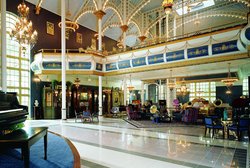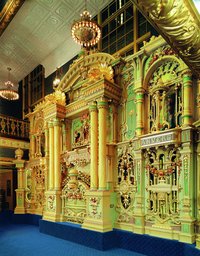 |
The Original Residence and First Music Room

Hidden away on 57 acres bordering a picturesque stream and thickly wooded hills, the original residence was a 6,000 square foot Tudor-style home built in 1974.
Inspired in the 1950s by the collection of nickelodeon pianos at Angelo Valente's 'House of Nickelodeons', (also known as the "Mil-Arm Inn", at the intersection of Milwaukee and Armitage in Chicago), the Sanfilippo music machine collection was started in 1978 with a small Nelson-Wiggen coin piano, a Bruder band organ, and a Welte Concert Orchestrion.
The 1927 Wurlitzer organ from the Omaha Riviera theatre, expanded to 24 ranks of pipes, made its debut at the 1984 Christmas party in the new 1,700 sq. ft. music room (known today as the 'American Orchestrion Room') which was large enough for concert seating, more music machines, chandeliers, Tiffany-style lamps and other antiques.
The beautiful art glass doors at the right side of the main Entry Foyer lead into the Music Room, a visual and aural treat described by some guests as unequaled anywhere else in the world. To the left is the musical centerpiece of the room, an 80-rank, 8,000 pipe theatre organ mostly hidden by a large scrim, or curtain, painted to replicate the original in the 1928 Chicago Paradise Theatre. The fringe hanging over the scrim is from the 1925 Uptown Theatre, and the five-foot-long tassels are from the 1912 Chicago Medinah Temple. The four large Perlman chandeliers with curved glass panels, made in 1927, are from the Milwaukee Garfield Theatre.

The immense orchestrion at the right front corner of the Music Room is a 1913 Welte Wotan brass band orchestrion, the largest known to exist. It originally provided music for an immense roller rink on Bois Blanc Island near Mackinac Island, Michigan. At either side of the rear stairway are a circa 1912 Style III Hupfeld Helios orchestrion with elaborate moving scene, and a circa 1920 Model III Hupfeld Pan with automatic 10-roll changer. The Helios plays the music of a German band, while the Pan closely imitates a European salon orchestra. Other orchestrions in this room include the largest known Philipps Mandolin PianOrchestra (a style 34A with five ranks of pipes, percussions and a 6-roll automatic changer), an early Weber Otero with an animated painted scene, a smaller Hupfeld Helios, and the only known original Pierre Eich Solophone with side cabinets, bass pipes and drums.
Smaller instruments in this room include a 26" Stella Orchestral Grand music box in a custom hand-carved mahogany console cabinet, a pristine gold-leafed Vernis Martin Victor Style XVI Victrola, a Home Model Mills Violano-Virtuoso, and a Victor Auxetophone, which uses an electric motor-driven compressed-air amplifier to produce an amazingly powerful tone for auditorium use.
The Music Room balcony is accessible via the cage elevator, the tower spiral staircase, and the entry foyer main staircase. The elevator is topped by an antique stained glass half-dome, with the matching second half a perfect replica of the original. The balcony is home to 67-key Limonaire, 65-key Gavioli and 82-keyless North Tonawanda fairground organs, a Wurlitzer brass pipe Caliola, music boxes and phonographs. The large bench with four lions (or are they camels?) is from the Medinah Temple.

The lower level of the Music Room is accessible via the cage elevator, the grand staircase, or the tower spiral staircase. At the foot of the stairs is a Mortier 115-key dance organ built in Belgium in the early 1920s, once used by Boltini's traveling circus. The elaborate facade includes twin gold-leafed carved lions.
A Regina Orchestral Corona 27" disc-changing music box in a unique birdseye maple-veneered case is located near the elevator on the lower level. The glass display case located around the other side of the elevator contains examples of rare pre-1900 phonographs. Many other rare phonographs are also displayed in the lower level of the Music Room, including a cylinder-changing 1905 Multiphone, the oldest known disc-changing John Gabels' Automatic Entertainer with automatic needle changer, a double-bell Duplex phonograph, Columbia phonographs in both upright and grand piano-style cases, an Edison Idelia, and a Paillard hot air phonograph powered by a kerosene flame. Music machines located in the lower level of the Music Room include the largest known Wurlitzer photoplayer, (a 1915 style K used in the Pastime Theatre, Coshocton, Ohio) and a lineup of small American coin pianos and orchestrions by Marquette, Nelson-Wiggen, Western Electric, Peerless, Coinola, Seeburg and Fox.
Toward the back of the room, an ornamental cage houses the Peter Clark lift mechanism, which raises the pipe organ console from the lower level to performance level, slightly above the stage platform, and also rotates it 180°.
Behind a large window are the organ blower, originally the backup blower for the San Francisco Fox Wurlitzer, and controls for the Deagan tower chimes.
Join our mailing list:
Please be assured that we never sell or exchange email addresses, this is for the Sanfilippo Foundation use ONLY.
© 2006 - 2020 The Sanfilippo Foundation,
All rights reserved.
The Sanfilippo Foundation
Barrington, IL 60010
email: info@sanfilippofoundation.org